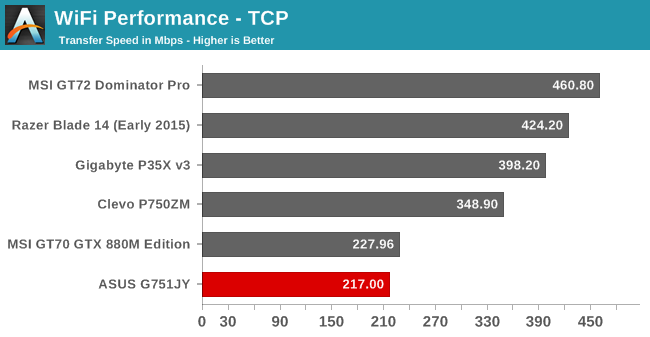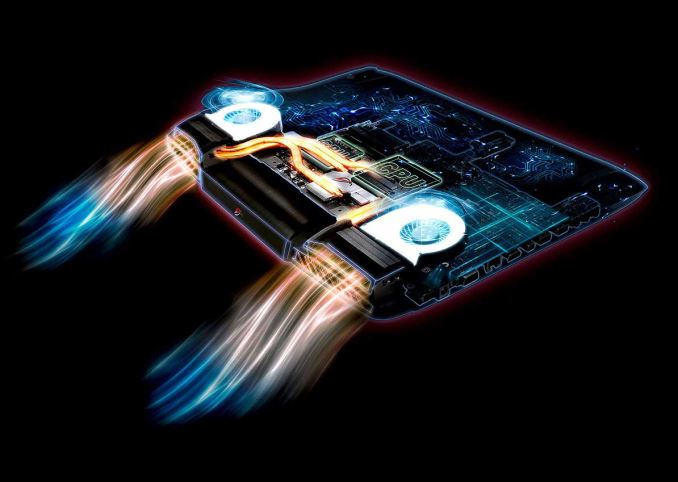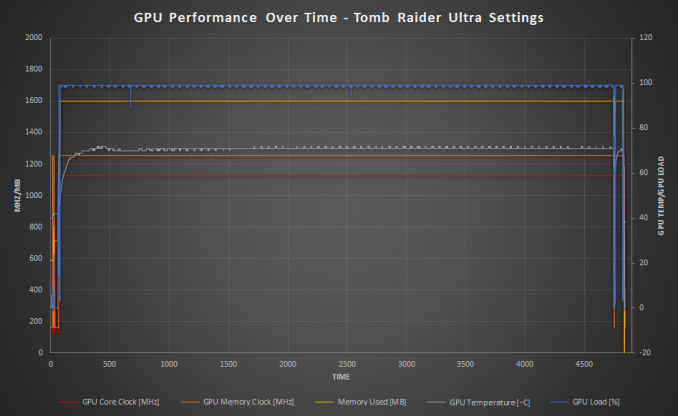The ASUS Republic of Gamers G751 Review: G-SYNC Comes To The Notebook Computer
by Brett Howse on July 29, 2015 8:30 AM ESTWireless
ASUS has turned to the fairly pedestrian Intel Dual Band Wireless-AC 7260 choice, which offers 802.11ac wireless as well as Bluetooth 4.0 capabilities. Intel does offer a newer version of this in the 7265, but it is offered in less form factors, so some OEMs have kept with the older model to keep the form factor they prefer. It does offer 2x2:2 capabilities for a maximum theoretical speed of 866 Mbps.

The Intel solution has never been one of the fastest out there, and in the case of the ASUS G751 I achieved even lower bandwidth scores that I would typically see out of this card. Out of the box, ASUS is using a drive from June 2014, but upgrading to the latest driver from Intel did not really help. If you do need better performance, the G751 does have a Realtek Gigabit Ethernet port on it, which I was able to get about 800 Mbps out of.
Audio
The ASUS G751 has two speakers at the rear of the device which are not visible, and appear to be coming out of the rear exhaust vent. It also has a subwoofer on the bottom to help out on the low end. It also has a SPDIF 3.5mm jack to allow it to be connected to external speakers. The audio software solution is fairly basic, with some reverb effects and an equalizer available.
Sound output was right around 80 dB, which is generally plenty of volume for most use cases. Frequency response is OK, and the included subwoofer does make a difference, although it is still a far cry from a dedicated speaker setup.
Cooling and System Noise
On a gaming laptop like this, cooling may be one of the most important factors of all. With the most powerful single notebook GPU under the hood, and a 47 watt processor, the system needs to expel all of that heat without sounding like a jet engine at takeoff. The ASUS G751 has two exhaust fans at the rear, with one for the CPU and one for the GPU. There are three heat pipes to transfer the heat out to the fans as seen in this graphic from ASUS.
To see how the system performs when doing what it is meant to be doing, I loaded up Tomb Raider set on Ultra, which will max out the GPU. This was left for about an hour or so in order to see how the cooling system performs over time.
The cooling system has no issue keeping up with the demands of the GPU, with a maximum temperature of just 72°C over the hour. The GPU frequency is maxed out for the duration, so there is no throttling going on. But even with this excellent cooling, the system fan noise was not overbearing in the least. I measured 45.2 dB with the sound meter an inch over the trackpad, which is a pretty decent result when the sound floor in my office is 36 dB. I wish I could measure the sound frequency as well, but the fans are sufficiently large to keep the frequency low and unobtrusive.
The G751 is edged out in system cooling by the MSI GT72 which kept the GPU closer to 60°C, but 72° from the G751 is perfectly acceptable with a 100% GPU load which Tomb Raider provides. And it does this without generating excessive fan noise, or high temperatures on the laptop casing itself. I don’t have a thermal camera (yet) but my IR thermometer showed a maximum temperature of 37°C at the hinge end of the device, with the keyboard and trackpad area staying very close to ambient, which is about 24°C in my testing environment.
Software
ASUS has taken a pretty light touch on the software side, which is certainly appreciated. There is a bit of extra software included which is worth discussing though, starting with the XSplit Gamecaster software which is pre-installed, and even has a dedicated button to start live game streaming. ASUS provides an unlimited recording license with the laptop, and the XSplit software supports all of the major streaming services including Twitch and YouTube, and it also allows saving the gameplay footage to your hard drive if you want to edit it before uploading, or just to keep it for historical reference.
It also offers customization to what overlays are displayed, and if you hook up a support capture card you can even use it to stream other events such as your console, although both the PlayStation 4 and Xbox One support live game streaming out of the box. For the group of people that are in to game streaming (sadly I don’t count myself in this group) this is a nice value add on the G751.
ASUS also includes their Game Center software, and it can be accessed with a dedicated button as well, which is in place of the standard Number Lock on the number pad. It offers quick access to many of the utilities including NVIDIA’s GeForce Experience software. It is also the quickest way to access ASUS’s Splendid Color application.
Splendid Color offers three presets, with Normal, Vivid, and Theater modes, and there is also a preset for a custom mode that you can configure yourself. I like these preset options from the manufacturers, as it gives the end user an easy way to adjust the display. But since I’ve been comparing the ASUS to the MSI GT72 as a direct competitor, I do like the extra option in the MSI version of this software which allows a higher gamma which is useful when playing a very dark game.
 Macro, Steam, and Game Streaming keys
Macro, Steam, and Game Streaming keys
Included software is generally added for either differentiation, or to increase margins (read bloatware), and ASUS has taken the approach to include useful applications. The game streaming add-on is always something you could add yourself, but for those that are into this, it’s nice to see it included, and with a dedicated keyboard button to launch it too. The combination of software and hardware is well done, and things like ASUS including three macro keys and the necessary software really display the focus on gaming with this machine.















52 Comments
View All Comments
Notmyusualid - Saturday, August 1, 2015 - link
^ Also this is true.Guys in work bemoanded my M3800 purchase back in December due to only having Haswell, and supposedly Broadwell was due out any day... But a machine was required immediately.
Broadwell shipped 8 months later, and in no numbers too! I'm not ever buying a 'U' Intel cpu, so those don't count.
Turns out my instinct (likely due to places like this), was right.
BMNify - Wednesday, July 29, 2015 - link
Around the corner?? Skylake H mobile will take atleast 6 months before launching in a new product like this, people buy when they need and don't wait half a year for updates.shadowjk - Wednesday, July 29, 2015 - link
Exactly. I'm still on 4700MQ + 780M.With "Skylake around the corner", nobody seems to want to sell even the few Broadwell-H laptops that allegedly exist, atleast in Europe. I'm guessing we'll be stuck on Haswell another 9-16 months..
boeush - Wednesday, July 29, 2015 - link
My guess is, nobody wanted to invest in Broadwell H inventory, when Skylake is soon to render it obsolete. OEMs are simply waiting for Skylake to refresh their models; they are skipping Broadwell pretty much just as Intel did.Refuge - Thursday, July 30, 2015 - link
Yes, this. No OEM's are paying Broadwell much mind. It was a flubbed launch when you look at its placement in the timeline. Timing was all wrong.Intel shouldn't have even bothered with it if they weren't going to push back Skylake, but oh well. At least the limited it to a very small launch.
douglord - Wednesday, July 29, 2015 - link
Totally pointless system for anyone that's not an engineer or architect that has to be able to take 3D drawings to customers.Why can't we get a 4 Core 45w chip with Iris Pro in a 5lb 15" laptop with all day battery life (10 hours)?
No we have to choose between a pointless 10lb gayming system with 1 hour battery life and 2 core ULP garbage in a 2lb folder.
BMNify - Wednesday, July 29, 2015 - link
I doubt you even read the article's first paragraph before commenting here, You are blabering about Engineers and architects and ignoring the name of the product itself: "Republic of Gamers", Hope you got a clue and its gaming not gayming. Hope i didn't hurt your gay feelings, homophobic people generally are just hiding their own insecurities and can be cured with proper help in coming out of the closet.Notmyusualid - Saturday, August 1, 2015 - link
doug sounds clueless to me.benzosaurus - Wednesday, July 29, 2015 - link
I believe the low-end Retina Macbook Pro is exactly the machine you're describing.boeush - Wednesday, July 29, 2015 - link
As an engineer (SW) who periodically deals with 3D graphics and modeling, I wouldn't bother with any 16:9 screen no matter the resolution. 16:10 is the minimal aspect ratio that is remotely acceptable for a workstation. 1080p is only suitable for movie watching, and is counter-productive for anything else.